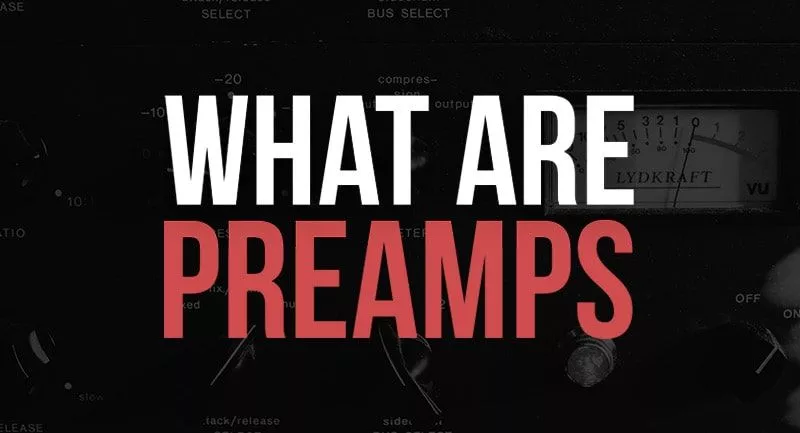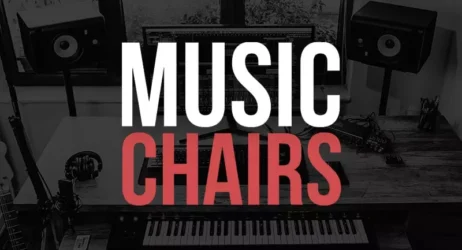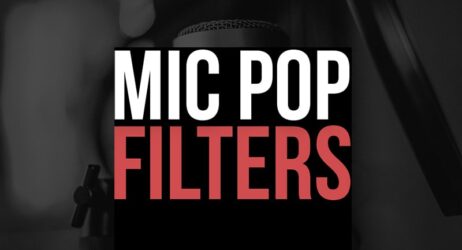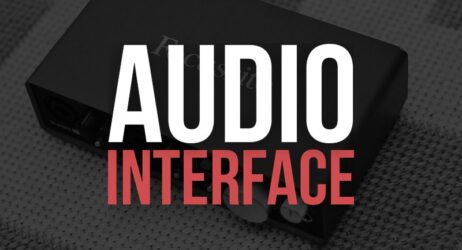This guide will answer what is a preamp, its purpose, the different types of preamps, and the difference between an amplifier and a preamplifier.
- What Is A Preamp
- Types Of Preamps
- Amplifier vs. Preamplifier
- How Do You Use A Preamp
- What Is The Purpose of A Preamplifier
- Does A Preamp Improve Sound Quality
- Does A Preamp Really Make A Difference
- How Do I Choose A Preamp
- The Best Preamps
What Is A Preamp?
A preamplifier, or simply ‘preamp,’ is an electronic amplifier that prepares a small electronic signal for further processing. It increases the strength of the signal in order to allow other components, such as an amplifier and a receiver, to function properly.
The preamp ensures that the signal can be carried through an amplifier, the next step in the audio chain. This will increase the quality of sound output from the audio equipment.
Preamps are often used in high-quality home sound systems. They make sure that amps and other components can properly process and amplify the signal.

Preamps have various inputs to accept signals from different sources, such as a microphone or a guitar. For example, a preamp in a home sound system may have an input for connecting different audio components, such as turntables and CD players.
What Is The Importance Of Preamps?
The preamp has a big influence on the sound quality you will get from your audio equipment. It is important to note that not all preamps are created equally. A high-quality preamp will produce better sound than lower-quality ones.
The preamp is the first amplifier in an audio chain. This means that it is responsible for preparing the signal to prevent overloading in the amplifier and other components in the audio system. If the signal is prepared properly, it will provide better sound quality.
The preamp can also change certain audio signal characteristics, such as the proportion of treble and bass. It can also raise or lower the audio signal volume before other components process it.
That’s why a preamp is an essential piece of equipment for any audio system. It prepares the small signals to be properly amplified before being processed by other components in the audio chain.
What Are The Different Uses Of Preamplifiers?
Preamps are used to amplify different types of signals, such as those from a microphone or a guitar.
A preamp in a home sound system may have an input for connecting different audio components, such as turntables and CD players.
Preamps can also provide different inputs to connect several audio components simultaneously. Preamps may also have volume control.
The preamplifier is an important component in the audio chain. It prepares the small signals to be properly amplified before being processed by other components in the audio system.
What Are The Different Types Of Preamps?
There are three basic types of preamps: current-sensitive preamplifier, parasitic-capacitance preamplifier, and charge-sensitive preamplifier.
Current-sensitive Preamplifier
Current-sensitive preamplifiers use transistors to amplify the current of the audio signal. They are quick at handling signals but have problems with impedance. They are not effective at low frequencies.
They are frequently found in old vacuum tube amplifiers. The sound produced by current-sensitive preamplifiers is not natural due to the distortion they can produce.
Parasitic-capacitance Preamplifier
Parasitic-capacitance preamplifiers use vacuum tubes. They are more effective at low frequencies but are slower than current-sensitive preamplifiers.
These preamps are frequently used in home audio equipment. They have a natural sound that is warm and musical, but they are more expensive than other types of preamps.
Charge-sensitive Preamplifier
Charge-sensitive preamplifiers use transistors to amplify the voltage of the audio signal. They are quick at handling signals and have fewer problems with impedance. They are effective at low frequencies.
These preamps are often used in home sound systems and other audio equipment. They are inexpensive and produce a natural sound.
What Is The Difference Between An Amplifier And A Preamplifier?
An amplifier is used to increase the strength of a signal. The preamplifier prepares the audio signal to prevent overloading in the amplifier and other components of an audio system.
A preamplifier also has different inputs to accept signals from different sources. An amplifier does not have these features.
An amplifier produces the audio signal, whereas a preamplifier prepares the audio signal to be produced.
That is why an amplifier must go through a preamplifier first to prepare the signal before being processed by other components in an audio system.
How Do You Use A Preamp?
How you use a preamp depends on how it’s connected to the rest of your audio system. In most cases, a preamplifier will go before an amplifier in an audio chain. The preamp prepares the signal to prevent overloading or distortion when it reaches the amplifier.
If your preamp has multiple inputs, use the input labeled “CD” for playing music from a CD player. The other inputs are used to connect equipment such as tuners, turntables, and tape players.
If your preamp has tone controls, turn them all the way counterclockwise. If it does not, turn the tone controls down until they don’t boost bass and treble frequencies.
Some preamps have loudness control. When you boost this control, it increases the bass and treble frequencies. Use this control to strengthen the sound of your audio system if you find the sound is not good enough.
If your preamp has a mono switch, use it if you are playing mono recordings or to make the sound clearer.
What Is The Purpose of A Preamplifier?
The preamp prepares an audio signal to prevent overloading or distortion when it reaches the amplifier.
A preamplifier has different inputs, which you can use to connect equipment such as tape players to your audio system to play different media types.
A preamplifier sometimes has tone controls, which you can use to adjust the bass and treble frequencies when they need to be boosted.
Some preamps have a loudness control, which you can use when the sound is not good enough or when you play mono recordings.
Does A Preamp Improve Sound Quality?
Whether a preamp improves sound quality or not depends on the equipment you use and your personal preferences.
A better preamp doesn’t necessarily mean you’ll have better sound quality. A high-end preamp might not even produce much of a difference compared to a cheap preamp in some cases.
In some equipment, a better preamp may produce more sound quality. However, it may not make a difference to others or may even decrease the sound quality.
Does A Preamp Really Make A Difference?
A preamp is an electronic device that takes a low-level signal from a source, such as a turntable or CD player, and boosts it to line level signal. Though some preamps may act as “active” volume controls, a preamp is not an amplifier.
Boosting the audio signal to line level gives it a stronger signal to work with and separates the audio signal from any hum and noise that may be present.
In the recording studio, a microphone preamplifier is used in the recording process to boost the signal of microphones.
Whether a preamp makes a difference or not depends on two things: the quality of the source signal and how much gain you want to apply.
A preamp may not make a difference if the source signal is already at line level, and you don’t want to apply too much gain, such as from a microphone or a low-level RCA input.
However, if the source signal is too weak and requires significant amplification, the result may be noise and other types of interference. In this case, a preamp makes a considerable difference in sound quality.
How Do I Choose A Preamp?
You want to make sure that the preamp you choose can handle the source signal and any other equipment you plan to connect to it. See if the preamp has the appropriate gain for your source and other components. If not, you’ll need to find one that does.
You also want to make sure that the preamp is compatible with your components. If you have a turntable, make sure it has an appropriate input for your phono cartridge. If you have a microphone, make sure it has an appropriate input for that type of microphone.
Your preamp should have the features you need to achieve good sound quality in most cases. However, if you plan on using more than one input or component, consider investing in a preamp with more features.
Preamps Overview
Preamplifiers are electronic amplifiers that prepare small signals for further processing. Signal strength is increased so that other components, such as an amplifier and a receiver, can operate properly.
A preamp, or preamplifier, plays an essential role in any audio or home theater system. It boosts low-level signals, such as those from microphones or music streamers, into a line-level signal suitable for further processing.
The preamp operates by taking an incoming signal, often a weak electrical signal, and increasing it to a level where the power amp or integrated amplifier can use it.
Tube preamps and solid-state preamps are two distinct types, each offering different advantages. Tube preamps are known for their warm sound, while solid-state preamps provide a cleaner signal path with minimal distortion.
Both types work to make the output signal strong enough for the power amplifier, but they do it in unique ways.
Phono preamps are another type of preamp specifically designed for turntables. They are unique because they not only amplify the signal but also apply a particular form of EQ known as the RIAA curve.
An audio interface, a device often used in recording, usually comes with a preamp and sometimes offers phantom power for microphones needing additional power.
Using separate components, such as a separate preamp and power amp, can make a big difference in the quality of sound produced. The gain stage, which is part of the preamp that boosts the signal, is critical for keeping the noise floor low and the signal above it, especially when recording.
Outboard gear like preamps and audio interfaces can improve the overall recording chain by offering better control over the input signal and output voltage. Line inputs, which are a basic form of audio input, can accept line-level signals, often coming from other pieces of gear or devices.
A better preamp can be noise tolerant, providing clean gain without introducing distortion or unwanted noise into the signal path. The resulting output signal then goes to the speakers for playback, connecting the listener to the audio in a very tangible way.
In conclusion, the humble preamp plays an essential role in setting up a home theater, recording music, or simply listening to your favorite tunes.
Its ability to make a big difference in sound quality by amplifying weak signals to an operating level suitable for further processing shows just how vital this piece of gear is.
Therefore, choosing the right preamp, be it solid state or tube, integrated or separate, can significantly improve your audio experience.
I hope you now have a better understanding of preamps and how to use them when creating music.




